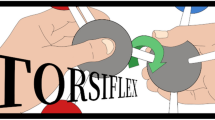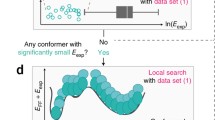Summary
A program which utilizes the techniques of Artificial Intelligence and Expert Systems to solve problems in the area of Conformational Analysis is described. The program searches conformational space in a systematic fashion, based on the technique known as heuristic state-space search. The program proceeds by recognizingconformational units, assigning one or moreconformational templates to each unit, andjoining them to form conformational suggestions. These suggestions arecriticized to discover logical inconsistencies, and any resulting stresses areresolved. The resulting conformational suggestions are sometimes accurate enough for immediate use, or may be further refined by a numerical program. The latter combination is shown to be quite efficient compared to purely numerical conformational search techniques.
Similar content being viewed by others
Explore related subjects
Discover the latest articles, news and stories from top researchers in related subjects.References
Singh U.C. and Kollman, P., QCPE Bulletin, 2 (1982) 117–145. (Gaussian 80)
Dewar, M.J.S. and Thiel, W., J. Am. Chem. Soc. 99 (1977) 4899–4917 (MNDO)
Pople, J.A. and Beveridge, D.L., J. Chem. Phys. 47 (1967) 2026–2033. (CNDO)
Wiberg, K.B. and Boyd, R.H., J. Am. Chem. Soc., 94 (1972) 8426–8430.
Burkert, U. and Allinger, N.L., A.C.S. Monograph, 177 (1982) 72–114.
Crippen, G.M., Distance Geometry and Conformational Calculations, Chemometrics Research Studies Series, 1, Research Studies Press, Wiely, 1983.
Corey, E.J. and Feiner, N.F., J. Org. Chem. 45 (1980) 757–764. (A part of LHASA limited to cyclohexane rings only.)
Cohen, N., Colin, P. and Lemoine, G., Tetrahedron 37 (1981) 1711–1721. (An excellent program, which joins simple templates with some abstraction, but does not examine intramolecular forces and strain relief directly.)
De Clercq, P.J., Tetrahedron, 40 (1984) 3717–3738. (A BASIC program limited to joining ring templates.)
Wipke, W.T. and Hahn, M., ACS Symposium Series, 306 (1986) 136–146. (A template assembly program which obtains its templates from an abbreviated X-ray data base.)
Dolata, D.P. and Carter, R.E., J. Chem. Inf. Comput. Sci. (in press).
Barr, A. and Feigenbaum, E. (Eds) The Handbook of Artificial Intelligence, Vol 2., William Kaufmann, Inc., Los Altos, CA, 1982.
Liljefors, T., J. Mol. Graph. 1 (1983) 111–117.
Vinter, J.G., Davis, A. and Saunders, M., J. Comput.-Aided Mol. Design. 1 (1987) 31–51.
Jochum, C. and Gasteiger, J., J. Chem. Inf. Comput. Sci., 17 (1977) 113–117.
Allen, F.H., Bellard, S., Brice, M.D., Cartwright, B.A., Doubleday, A., Higgs, H., Hummelink, T., Hummelink-Peters, B.G., Kennard, O., Motherwell, W.D.S., Rodgers, J.R. and Watson, D.G., Acta Cryst., B 35 (1979) 2331–2339.
Murray-Rust, P. and Motherwell, S., Acta Cryst., B34 (1978) 2534–2546.
Murray-Rust, P. and Raftery, J., J. Mol. Graph, 3 (1985) 50–56.
Taylor, R., J. Mol. Graph., 4 (1986) 123–131.
Karle, I.L., Gilardi, R.D., Fratini, A.V. and Karle, J., Acta Cryst., B 25 (1969) 1469–1479.
Geise, H.J., Romers, L. and Rutten, E.W.M., Acta Cryst., B 20 (1966) 249–257.
Gylbert, L. and Carlström, D., Acta Cryst., B 33 (1977) 2833–2837.
McConnell, J.F., Cryst. Struct. Comm., 2 (1973) 459–461.
KrishnaMurthy, H.M., Bhat, T.N. and Vijayan, M., Acta Cryst., B38 (1982) 315–317.
Shen, M., Ruble, J.R. and Hite, G., Acta Cryst., B 31 (1975) 2706–2709.
Gabe, E.J. and Barnes, W.H., Acta Cryst., 16 (1963) 796–801.
Bartell, L.S. and Bradford, W.F., J. Mol. Struct., 37 (1977) 113–126.
Bhattacharjee, S.K., Chacko, K.K. and Zand R., Acta Cryst., B 35 (1979) 399–401.
Clocksin, W.F. and Mellish, C.S., Programming in PROLOG, Springer-Verlag, Berlin, 1981.
Burkert, U. and Allinger, N.L., J. Comp. Chem., 3 (1982) 40–46.
Author information
Authors and Affiliations
Rights and permissions
About this article
Cite this article
Dolata, D.P., Leach, A.R. & Prout, K. WIZARD: AI in conformational analysis. J Computer-Aided Mol Des 1, 73–85 (1987). https://doi.org/10.1007/BF01680558
Received:
Accepted:
Issue Date:
DOI: https://doi.org/10.1007/BF01680558




